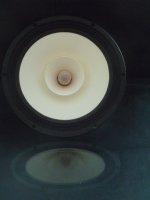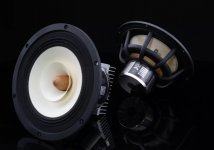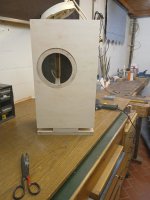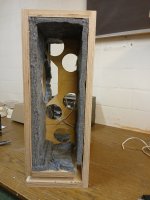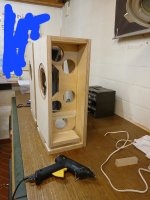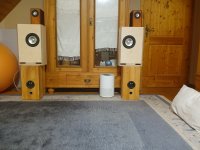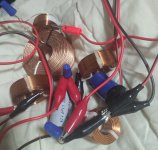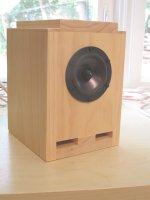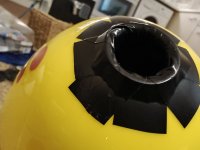Curved arrays are better than straight arrays, that’s why you see them in all kinds of concert venues.
It is not that simple, that venues would blindly use them because they are "better". One of the biggest reasons they use them curved is that some people are really close to the speakers and some are far and yet both would need to have similar volume as possible.
"‘J’ array. Comprised of a straight line portion and a curved portion at the bottom. This provides a long throw straight line component for people relatively far away, while the curve at the bottom acts as an in-fill for the area directly in front of the array."
So as you see, the reason is very different than at some persons home system in a living room. That is why I have a straight array in my living room, because for my specific needs, it is "better" than curved. 🙂
Update: added plast-tape to the 5.25" Eve Audio honeycomb's soft dustcap, somewhat taming its 5.5khz breakup resonance; after 0.47mH first-order LPF only a broad, very subdued hump was left. Also made a perch for the Naturelle and confirmed 23.4ohm->2.7uF gave a flat combined treble response. Then in place of the dipole Naturelle, I decided to try a 4" paper-cone closed-back alnico Siemens, one of the better tweeters of that type and vintage. Much easier to "sit" over the Eve and their acoustic centers matched exactly when the flanges' back faces were aligned (found by ear, even 1mm made a huge difference in naturalness and monophonic depth). More relaxed sounding than the Naturelle and just on the sweet side of neutral. Spec-wise the Siemens couldn't match the dipole or even modern dome tweeters, but it was extremely clear and smooth. Interesting combination of old and (relatively) new tech. Potentially A/A+/A 2-way, A/A+/A+ 3-way LX (which cost about $300 including Jantzen aircore and SilverZ).Couldn't leave well enough alone... I inserted the Eve 5.25" nude driver above the 6.5" forming a 3-way LX -- Naturelle perched precariously above; their acoustic centers all lined up. Simplified the first-order XO (0.15mH->6ohm 6.5" up-firing; 0.47mH->5.25" frontal; 23.4ohm->2.7uF->8ohm Naturelle) but only had a few spare minutes to tweak. Anyway tone-sweep sounded pretty flat. If I had any sense this ought to be the end of diy.... Quite shocking how much more of musicians' intent and performance nuance came through.
Fat Cat!
Last edited:
try a 4" paper-cone closed-back alnico Siemens
From the front i would have guessed Isophon, but the details are a bit different. Ihave run across 4 versions, larger & smaller volumes in both sealed and aperiodic varieties. These are teh small aperiodic.
dave
Also tried without the 108 but a steel bowl deflector instead (in fact another 108's former home). Omni horizontal and pretty much vertical as well. Needs a half dome of up-tweeters I think. Then I put back the 108... musicians' favorite yeah goosebumps.And another in the same league as micor55 and Naturelle (LX versions) -- The Eazies: Fostex FE108eΣ and alnico copy of 168eΣ (obviously original Fostex cone/surround) placed over 27L steel can. The 108 has a very steep rise 1.5-2khz that I used to shelf-filter boldly. But with the 168 up-firing and naturally attenuated approaching 2khz, this LX configuration only needed a resistor-chain (23.4ohm on-hand) to make a pretty flat response 55hz-11khz more or less. Crossover-less, seamlessly integrated, acoustic centers aligned, and very wide vertical and horizontal directivity/dispersion -- if not quite omni-directional.
Last edited:
Cool aperiodic. Wonder if stuffing inside has powderized. I think this year there has been much less mass-import of vintage audio into China, as prices turned lower. Top English vintage audio are relatively rare and sell quickly. German and Japanese not so.From the front i would have guessed Isophon, but the details are a bit different. Ihave run across 4 versions, larger & smaller volumes in both sealed and aperiodic varieties. These are teh small aperiodic.
View attachment 1335984
dave
Dayton Audio PS180-8 6.5” Point Source.
Really nice mid range and clear imaging, stereo separation.



Really nice mid range and clear imaging, stereo separation.
I finished my sealed egg-shaped enclosures. I'm using a pair of Tang Band W3-881SJF 3" Full Range speakers.
The high end is handled by Dayton Audio PTMini-6 Planar Tweeters, with custom cardboard waveguides.

I also have ports for the enclosures, which are designed for children's gifts at Easter, but I'm enjoying the sound of them sealed.
Is it always a good idea to port full-range enclosures?
The high end is handled by Dayton Audio PTMini-6 Planar Tweeters, with custom cardboard waveguides.
I also have ports for the enclosures, which are designed for children's gifts at Easter, but I'm enjoying the sound of them sealed.
Is it always a good idea to port full-range enclosures?
Hmm that would make a very cool design 😎Can't you make the high frequency waveguide more like ladybird wings? Perhaps stick some legs on as well.
My Tang Bands are 0.72. I have a passive subwoofer for bass, so I'm probably not missing out on anything.Not always.
There are some full range drivers/speakers with high QTS (say about 0.71 or higher) that would be more accommodating to sealed or Open Baffle.
I like the A3 waveguide, how’s it sound?I finished my sealed egg-shaped enclosures. I'm using a pair of Tang Band W3-881SJF 3" Full Range speakers.
The high end is handled by Dayton Audio PTMini-6 Planar Tweeters, with custom cardboard waveguides.
View attachment 1342949
I also have ports for the enclosures, which are designed for children's gifts at Easter, but I'm enjoying the sound of them sealed.
Is it always a good idea to port full-range enclosures?
For example, high quality speakers such a SONIDO SWR 096/FC, SWR 200/FC and SWR 250/FC whose quality can be adjusted using a power supply. But the high OTS factor of the closed boxes is not suitable. And in the case of the closed box, the total QTS (speaker together with the box) sound be 0,71.Not always.
There are some full range drivers/speakers with high QTS (say about 0.71 or higher) that would be more accommodating to sealed or Open Baffle.
Attachments
Thanks 🙂 They sound better with the waveguide, but cardboard might not be the best material. I tried out a few different shapes, and settled on the shallowest design. I want to remake them out of flexible plastic.I like the A3 waveguide, how’s it sound?
One possible solution would be to make a mold of the cardboard master with two part silicone…then pour plastidip into the mold.
Another option is to make another one out of cardboard…then just paint it thoroughly with plastidip.
Plastidip, silicones, and two part resins are easy to work with once you get used to their preferences.
Plastidip likes to be poured into glass containers (as do the two part resins)…they will eat right through styrofoam and thin plastic cups.
Another option is to make another one out of cardboard…then just paint it thoroughly with plastidip.
Plastidip, silicones, and two part resins are easy to work with once you get used to their preferences.
Plastidip likes to be poured into glass containers (as do the two part resins)…they will eat right through styrofoam and thin plastic cups.
Last edited:
I believe it is available in black and also in yellow. I have the black….very similar to liquid electrical tape… but cures to a slightly more rigid substrate.

One of Daves new CGR for the CHN110. Ist the midsized one.
The boxes acting as stands are small reflexes for CHP90 from Scott. :^
Bass from the CGRs is full and refined. I have a problematic room and the CGRs with its resistive vent do fit good better then the small reflexes.
Iam still in the first 10hours of playing and starting low, but from the first go they sound unobstrusively to me. I like that a lot.
The boxes acting as stands are small reflexes for CHP90 from Scott. :^
Bass from the CGRs is full and refined. I have a problematic room and the CGRs with its resistive vent do fit good better then the small reflexes.
Iam still in the first 10hours of playing and starting low, but from the first go they sound unobstrusively to me. I like that a lot.
Attachments
Continuing my LX series: "Metals" KEF LS50 Meta AlMg-cone/Al-tweeter coax over Monitor Audio 7" dimpled AlMg woofer over 27L closed steel can. Not fullrange driver obviously, in fact ~2.5-way (1st/3rd/~2nd-order XO ~450hz/2700hz), but still relatively simple due to "LX" (OB and off-axis natural fall-offs). Frequency response is flat enough. Coax part described earlier in multi-way forum:
https://www.diyaudio.com/community/...ed-to-off-the-shelf-stuff.414702/post-7765904


https://www.diyaudio.com/community/...ed-to-off-the-shelf-stuff.414702/post-7765904
Attachments
hi folks,
It has been a while, but I have a new build. Wanted say thank you to Planet10 for a wonderful, easy box design for the Dayton RS-100-8. I had some nice pine available and the speakers.... Built to spec as per design. The bass is great for desktop/small room and they seem to like less complex music, which is fine by me. they might be even too hi-fi, but am pleased with construction, which is always the challenge.
best,
Jeff ( now in Portland OR)
It has been a while, but I have a new build. Wanted say thank you to Planet10 for a wonderful, easy box design for the Dayton RS-100-8. I had some nice pine available and the speakers.... Built to spec as per design. The bass is great for desktop/small room and they seem to like less complex music, which is fine by me. they might be even too hi-fi, but am pleased with construction, which is always the challenge.
best,
Jeff ( now in Portland OR)
Attachments
I noticed some standing waves in the voice range frequency. I didn't think that would happen in an egg-shaped enclosures, with no parallel walls, but my ears pick them up. So I installed ports. Seems to have solved the problem.I finished my sealed egg-shaped enclosures. I'm using a pair of Tang Band W3-881SJF 3" Full Range speakers.
The high end is handled by Dayton Audio PTMini-6 Planar Tweeters, with custom cardboard waveguides.
View attachment 1342949
I also have ports for the enclosures, which are designed for children's gifts at Easter, but I'm enjoying the sound of them sealed.
Is it always a good idea to port full-range enclosures?
Attachments
- Home
- Loudspeakers
- Full Range
- Full Range Speaker Photo Gallery
